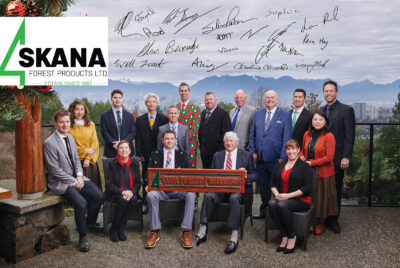
President & CEO of the American
Wood Council
The American Wood Council (AWC) played a leading role in getting the mass timber construction types incorporated into the International Code Council’s (ICC) model building codes, which opened 2.25 billion board feet of market opportunity to wood products.
We didn’t stop at this significant achievement. To ensure that mass timber construction continues to gain traction in the United States, AWC continues to dedicate significant resources to education and outreach efforts across the country in support of adoption of updated ICC mass timber code provisions. Including states with jurisdiction specific adoption of mass timber, 28 states have adopted mass timber provisions, up from 21 states in 2022.
AWC uses a combination of education and direct outreach to code and fire officials in key jurisdictions to build understanding and support for mass timber adoption. For example, in Ohio this past year, AWC presented on the mass timber provisions to over 100 code officials at the Building Officials Conference of Northeast Ohio and was a regular participant in meetings of the Ohio Building Codes Committee to support the committee in addressing any questions while in development of the approved code package. These efforts helped pave the way for the Ohio Board of Building Standards’ vote to approve the code package to adopt the 2021 IBC with an effective date of March 1, 2024. The approval includes the new mass timber provisions first introduced in the 2021 IBC.
AWC was also very active in 2023 in providing technical support to the District of Columbia’s Construction Codes Coordinating Board (CCCB) on adoption of the 2021 I-codes. The situation in Washington, DC has been complicated by concerns with the energy code provisions in the 2021 I-codes, and the CCCB is currently reviewing the full 2021 I-codes for possible enactment in 2025.
AWC has pivoted to work with members of the CCCB to develop a comprehensive set of changes to the existing building code specific to mass timber in lieu of waiting out the current code development cycle. This support was critical in leading to the CCCB’s decision to approve several mass timber code changes, essentially completing the Board’s work to update the 2017 DC Building Code to include 2021 and 2024 International Building Code provisions for mass timber structures.
The mass timber update is being classified as an emergency code measure and could be considered for immediate enactment by the District Council early next year. AWC will remain active in the process to ensure the District’s Council acts swiftly.
The situation in DC is playing out in many other states across the country, including Florida, Idaho, Indiana, North Carolina and Wisconsin. Processes and actions to slow or halt the adoption of updated codes despite widespread technical support appear to largely be driven by political interests, often rooted in avoidance of costs associated with new energy codes. AWC has proactively sought to assist in jurisdiction efforts to separate adoption of the energy code from other model code provisions and also moved to develop an approach that would enable jurisdictions to more easily approve mass timber through alternative methods and materials provisions of the building code.
The test case is in Florida, where the Building Officials Association of Florida Board of Directors voiced support of AWC’s development of an Alternative Methods and Materials (AMM) guide for the state to assist the code official in review and permitting of mass timber buildings through the AMM process. The guide, now available on the AWC website, combines all of the relevant mass timber provisions in the 2024 I-Codes for use with the adopted Florida code, making it very easy for both code officials and builders to review the most up-to-date code requirements for mass timber structures.
AWC has worked with a number of building and fire officials throughout the state to familiarize them with the AMM guide and build a comfort level that can help make it easier for builders to use it going forward. The guide will also help to familiarize code officials with mass timber requirements ahead of efforts to incorporate them into the 2026 edition of the Florida Building Code, which begins its update cycle in 2024.
AWC is optimistic that the AMM guide will be widely recognized by building officials in the state, even though Florida declined to adopt the mass timber provisions in 2022. The Florida experience will help inform future approaches in jurisdictions that continue to reject updates to their building codes due to concerns like energy code adoption costs. AWC will continue to seek adoption of the mass timber provisions in all 50 states, and this AMM guide is just another example of the creativity, expertise and dedication AWC staff bring to the effort on behalf of the wood products industry.






